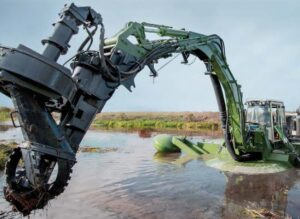Context:

• The Delhi government has procured an advanced dredging machine from Finland to undertake large-scale cleaning of the Yamuna River and mitigate flooding and pollution.
• The machine was unveiled by Delhi Water Minister Parvesh Verma and is expected to be operational from January.
Key Highlights / Details:
About the Machine
• Name: Amphibious Classic 4 Multipurpose Dredger Machine
• Cost: ₹8 crore
• Imported from: Finland
• Functions: Dredging, desilting, and cleaning operations
• Additional Use: Will also be used to clean the Najafgarh drain, a major contributor of pollution to the Yamuna
Significance for Yamuna Cleaning
• The machine will enhance dredging capacity, enabling removal of silt and solid waste more efficiently
• Equipped with energy-efficient hydraulic systems and modular technology
• Can operate in both land and water – increasing usability in shallow and marshy areas
Government’s Action Plan
• Marks a technological intervention under Yamuna cleaning initiatives
• Public-private partnership to enhance river management strategies
• Officials stated the machine will boost flood management capability as well
Long-term River Restoration Vision
• Authorities plan to procure more such dredgers
• Government exploring global collaboration to bring advanced river-cleaning techniques to Delhi
Relevant Prelims Points:
• Issue: Yamuna pollution caused by sewage discharge, industrial waste, encroachments, and solid waste dumping
• Causes: Poor wastewater treatment, high population density, Najafgarh drain pollution load
• Govt Initiatives: Yamuna Action Plan, Namami Gange (Phase II), Interceptor Sewer Project
• Impact: Improved flood control, reduction of siltation, better water flow
Relevant Mains Points:
• Yamuna cleaning linked to urban river governance and sustainable development
• Technological interventions are crucial for environmental rejuvenation
• Supports SDG 6: Clean Water and Sanitation
• Public–private partnerships ensure accountability and efficiency
Way Forward:
Expand sewage treatment capacity, enforce polluter pays principle, promote decentralized wastewater technologies, strengthen real-time water monitoring systems




